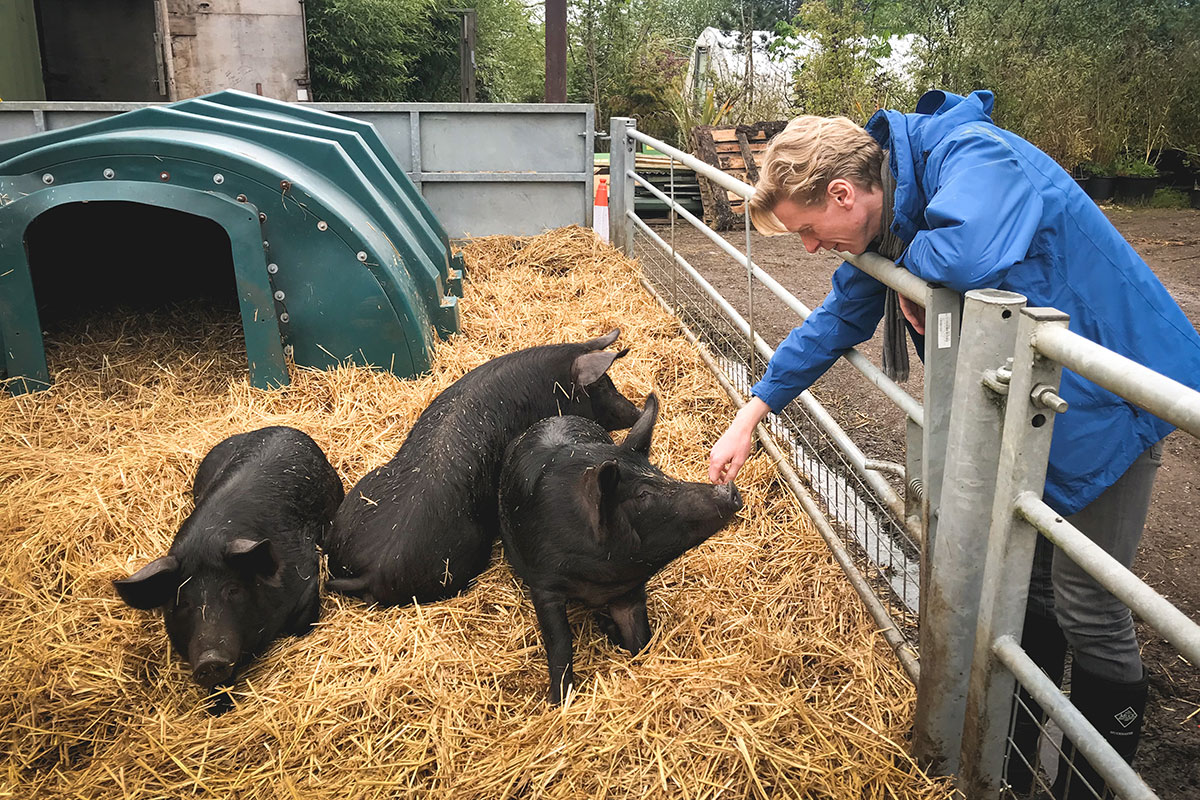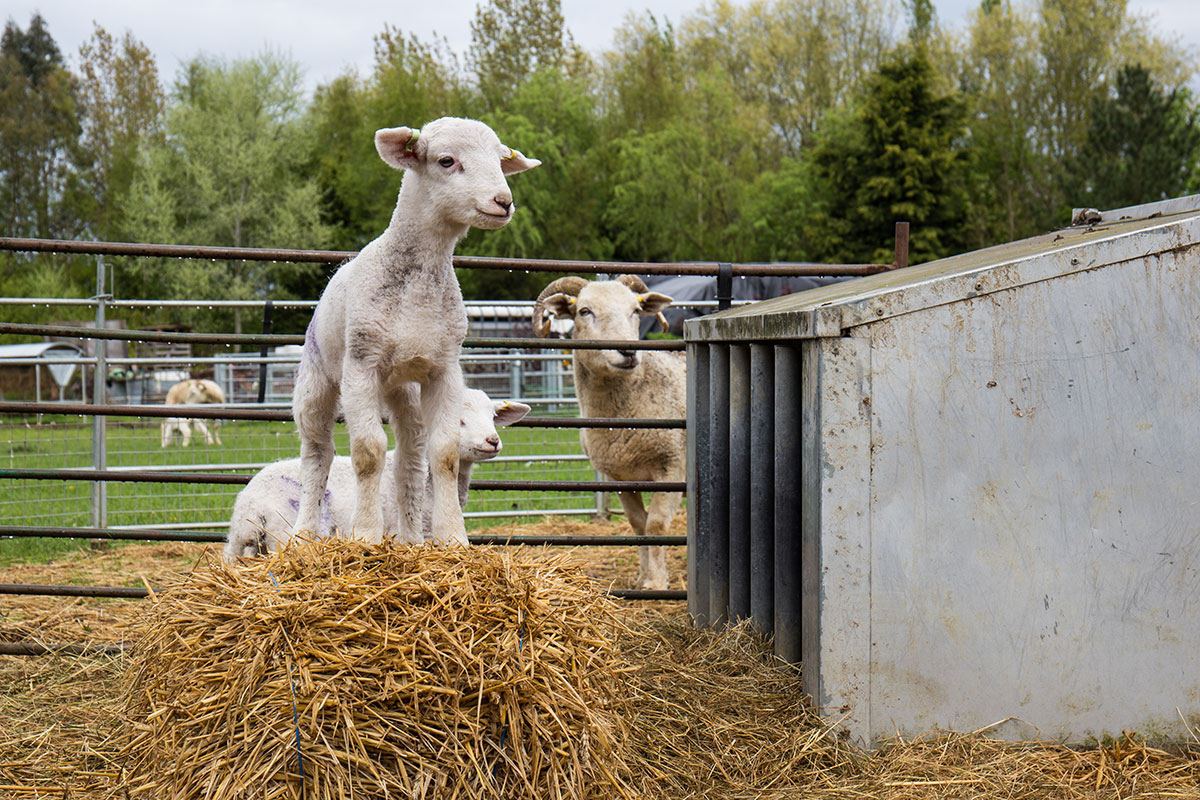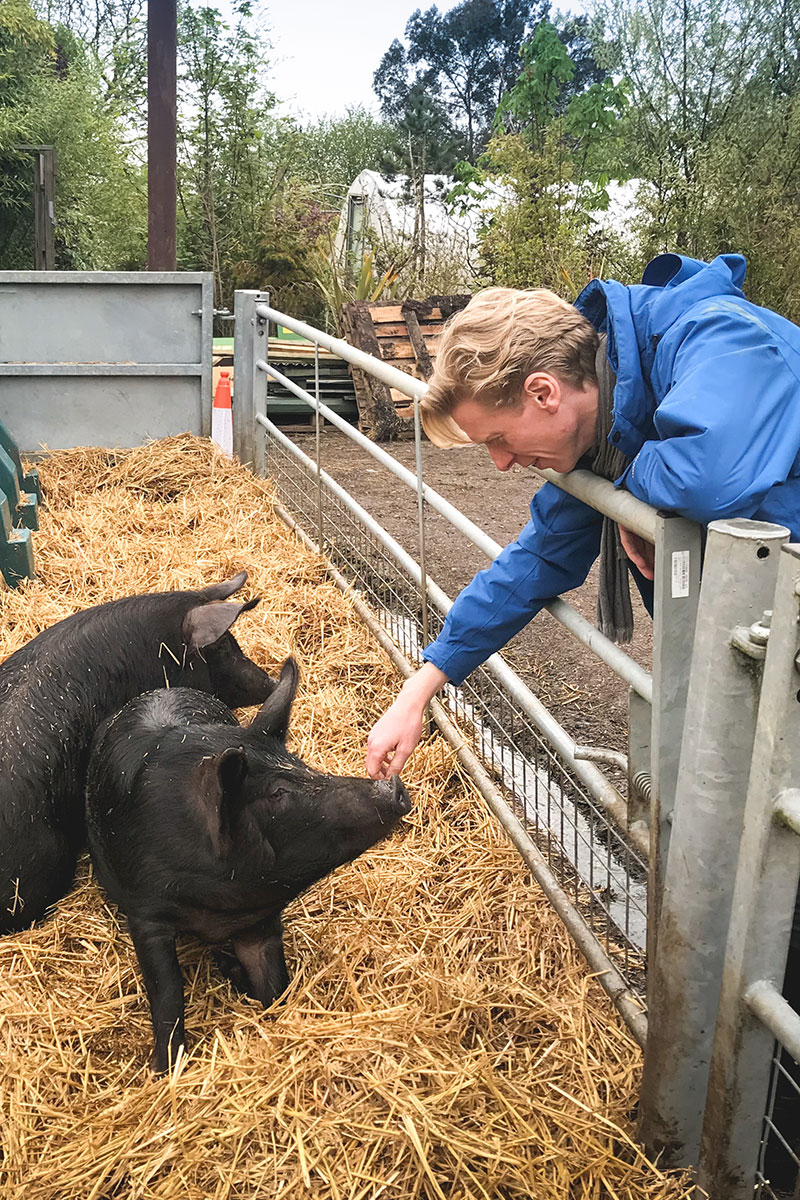
Continued from Part 2: "It's an eating dog world"
Entering Andy's farm, there was a garden centre feeling to it. Not a kitsch, OAP populated tea room, but an absence of the sprawling, muddy, farmyard surrounded by barns stacked with hay and tractors. The driveway was lined on both sides with potted plants of all sizes, from waist-high saplings through to towering specimens, as if we were entering a nursery for rare and exotic plants, before the driveway finally opened out, with the requisite hay-filled barns loomed into view.
Andy is an avid horticulturalist, growing various unusual bamboos on his labyrinthine farm, which has been developed from bare fields and a caravan into a rural idyl with a farmhouse over the last twenty-odd years. There's also a plethora of unusual looking chickens, geese, sheep, cows and the reason for our visit - rare breed pigs. Specifically, the three sisters, a black-haired, enthusiastic and talkative trio who grew up together on the farm. Standing at a year of age, these Large Black Tamworth cross pigs had reached double the age of a factory farmed pig that has been raised for meat.
We'd come to meet our dinner.
Theresa, as we named her, was one of the friendliest, happiest and excitable animals that I've ever met. She and her sisters were frolicking around in their pen, clearly excited at the attention they were receiving from the visitors. They were confident, bustling around in their hay-lined pen, oinking, grunting and snuffling at us and each other, happy to be petted, stroked and treated like one of the family. Andy proudly told us of their lineage, knowing the history of the animals, who parented them and an encyclopaedic knowledge of these animals' family tree. People talk of happy meat and these three little pigs were the epitome of it, they were truly gruntled.
This sits in polar contrast to descriptions of intensive meat production. In his book 'Cooked', Michael Pollan describes a visit to an American factory pig farm, otherwise known as a Concentrated Animal Feeding Operation (CAFO) or feedlot. These vast animal factories are renowned for their repugnant aroma and questionable treatment of animals. His stark memories of it call upon Dantean imagery to describe how awful it was:
"...and it was a place I won't soon forget: a deep circle of porcine hell the stench and shrieking squeals of which I can still vividly recall"
Modern stereotypes of farming, with vast monocultures and intensive animal rearing, sheds crammed full with thousands of animals packed so tightly they can barely move, sit in stark opposition to the diverse, undulating rural utopia of Theresa's home.
Standing in front of these animals, something got in the way. I felt a wave of sadness in recognition of my role as the agent of their demise. The following week, Theresa and her sisters would be trailered to an abatoir, where they would be slaughtered. Although someone else would be pull the trigger, so to speak, I was complicit in the process and harking back to Bernard, there was discomfort at being the author of any pain that might be inflicted upon these animals.
Primarily, the discomfort was founded in the fact they would cease to exist as living breathing creatures, just so that we could eat dinner.
In the UK, pigs are stunned before they are killed, to ensure they a rendered insensible to any pain and to provide a humane death. Once stunned, they are hung up and ‘sticked’, meaning their throat is cut and the blood drained, causing death. This process is intended to remove any unecessary suffering for the animal, but however it’s described, it sounds harrowing. Theresa and her sisters lived their idyllic lives in a rural haven, before they got carted away and quickly killed for our consumption.
Suddenly, it all felt rather sombre and left me wondering whether I wanted to be involved in this.
Later that day, sitting in a small tapas restaurant eating various dishes which, ironically included pig’s tongue, I expressed my dismay at ordering the death of another living being. I felt disturbed after meeting these gregarious, friendly pigs and knowing that the following week, they would be trailered to the abatoir and slaughtered at our behest.
Holly, a horticulturalist friend who grew up in the countryside was at the opposite end of the scale, having witnessed the birth and death of animals on many occasions. For her, this process is the natural cycle of life, plants are grown, animals are raised, eggs are sold, and finally the animals are killed, sold or eaten along with the edible plants. It seemed that to her, there’s nothing extraordinary about this process, it’s a lifestyle that has been perpetuated for thousands of years since farmers first domesticated pigs, chicken and sheep.
The nurturing and slaughter of animals is a historic normality, which sustains the world around us.
As a city dweller, nothing could be further from my reality. When a fox killed one of our family rabbits as a child, my parents cleared up the mess before I could see it. My first living memory of close contact with a dead animal was around the age of 10, when staying on a farm in Yorkshire. A few days earlier, a ram had, quite literally, locked horns with another and suffered a broken neck in the resulting scuffle. David, the farmer, was taking us into town and wanted to drop the dead animal at the kennels en route.
Outside, behind the stone rear wall of the barn, on a gentle incline of broken grass, amongst various pieces of farmyard paraphernalia, was a large blue tarpaulin, which pulled back to reveal a dead, bloated ram. David asked if my father and I could give him a hand. I looked at my father, who looked at David and politely declined his gracious offer.
“Well, I can probably do it myself ” muttered David as he gathered up the front hooves in his left hand and the rear hooves in his right hand. With a fearful strain and lean, he managed to hoik the corpse up to his waist, swing around, then with a flick, grunt and a bend of the back, lift it slightly higher again, into the waiting load space of his Land Rover.
We all jumped in, myself in the back seat with just a thin layer of sponge, spring and vinyl seat between myself and the ram. I felt uneasy with the presence of death in such close quarters, I didn’t know what to do with it. As we drove down the road, I began to sense what to do — get as far away as possible, because it reeked with a pungency that I’d never experienced before or again since. The stench of decomposing ram is the most repugnant smell I have ever experienced, evoking an unparalleld a sense of repulsion. I guess it’s this smell of death which leads forensic officers to put Vicks Vapo-rub in their nose. I fully sympathise.
Windows down, David darted across the top of the Yorkshire moors referring to the speed limit as nothing more than a suggestion, one to be wholly ignored in this instance. I spent the entire journey with my head pushed as far out of the window as possible. Cold, damp, air being forced into my mouth and ears at over 70mph was infinitely preferable to the smell of decaying flesh. When the barrage of the elements became too much to bear, I’d bring my head back inside the vehicle, only to be confronted by THAT odour again, causing my head to richochet straight back out of the window.
We arrived at the local pub for lunch, having watched David unload the ram, single handedly of course, at the kennels. One of the locals asked “were that you I saw racin’ across the moor at 100mph earlier?”, David said “Aye, had these two and a dead ram in the back, they didn’t like the smell” and at that, we sat around joking about how soft, weak and uncomfortable my city-dwelling father and I were with the presence of dead animals.
Oh, how we all laughed.

Andy’s farm mirrored this, it truly was a place of life and death on the day we visited. Lambing season was in full swing and Andy excused his sleep deprivation, for he had been rising every few hours throughout the night to check on his flock and tend to any newborn, which included dealing with the occasional death.
The term ‘husbandry’ refers to the day to day care of animals, which befits Andy’s profound devotion to the land and the creatures which live upon it. This love and care was clearly demonstrated in the way he spoke about the farm and the way he cared for his extended family. Money, what comes of it, seemed an afterthought, a necessity of life out there, beyond the environment of the farm.
Before we left, I went back to the pig pen, finding Theresa and her sisters napping top to tail in the hay. Begrudgingly, she lifted her head as I gently stroked her shoulder. I said goodbye to Theresa and thanked her, engulfed in sadness at her insouciance regarding her impending demise — of course, she was utterly unaware.
Do I pray? Offer a blessing? Endings are always sad. She lifted herself up, with a few awkward snuffles and croaks, as if to say “damn, I was asleep” but the prospect of human attention was strong and soon, she and her sisters were on their feet, nose through the gate, sniffling and licking at their new pals, the humans.
Mate, what am I doing?
Continued in Part 4: ‘Reactionary Veganism’

